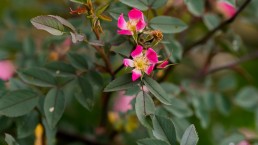Herbal Actions: Aromatics
Herbal Actions
What is a “herbal action”?
When we speak about the action(s) of a certain plant, we are referring to one or more effects a plant can have on our body. Often these actions are explained in two or three words; however, herbal actions are so much more than that! Since plants are wonderful complex beings, they also have several actions. Most herbs can compliment their action(s) in combination with another herb, basically showing off their best side with the support of a “good friend”. Sometimes they work great on their own, but most of the times, they excel with a good buddy on their side. Think- Teamwork!
Aromatics
Imagine walking through your garden, on your favorite trail, or through the quiet woods. Try to picture this beautiful abundance of growth using your senses. Can you see all the different colors, hear the leaves dancing in the light breeze, feel their softness or even their sharp thorns on your skin? Can you smell the plant? No? Try crushing a leaf… How about now? Can you give it a little taste test? Mild? Bitter? Pungent maybe?
If you have been learning from and with our wonderful plant friends, chances are, you have come across the term/action, “aromatic”. Now let’s get back to our imaginary herb walk from just moments ago. It was right there were you have come across a “sense-able”, or “foundational” (as Herbalist Jim McDonald calls it) action of an herb. An action you can immediately experience using your senses.
When talking about aromatic herbs, we refer to herbs one can easily smell by releasing their oils (referred to as volatile oils or essential oils) from their special secretory structures, such as oil cells, epidermal hairs or resin ducts. Most of the time, this release of oils happens, when the leaves or other plant parts have been crushed.
Did you ever ask yourself why a plant even has all these essential oils and/ or amazing actions? They actually have a variety of natural functions within themselves and act for example as growth regulators, protection from heat or cold or serve, for interplant communication or to attract pollinators.
Before giving you a little glimpse on how aromatic herbs can support our body, please let me clarify that I am writing about aromatics and the action of essential oils within the whole plant, and not the distilled, isolated essential oils (EO) you can buy in little brown bottles. Due to the isolated EO’s high potency, they act very different on the body and should be only used with care and the support of a trained aromatherapist.
Examples of some Aromatic Herbs
Lovely herbs for the respiratory system include Angelica archangelica (Angelica) or Thymus vulgaris (Thyme). With both of them being expectorant, anti-microbial and anti-spasmodic, the volatile oils in the plant help liquify the mucous in the bronchi and transport it upwards via a productive cough.
Lavendula (Lavender) is a wonderful relaxing nervine. Coffee spp. (Coffee- anyone?) on the other hand, is a fabulous stimulating nervine (please note, coffee will only excel if used in moderate doses and if you rule the coffee, not the coffee rules you…) – you got it, both aromatics can be used to address the nervous system.
Often aromatics are referred to as carminatives. I personally see the term carminative as a sub-category to aromatics, specifically in regards to the digestive system. Aromatics/ carminatives are of great help when, for example, fermentation in the stomach becomes a problem. My favorite herbs for the digestive tract include Zingiber officinale (Ginger), Foeniculum vulgare (Fennel) or Matriacria recutita (German Chamomile)
I hope this post gave you a little insight on aromatic herbs and how they can interact with our body. This topic is covered much more in depth in the herbal course, which is currently developed and coming soon by our group of wonderful herbalists.
Resources:
Besides my own words, this write up features information from the following resources:
– Ursel Buehring Praxis- Lehrbuch Heilpflanzenkunde – Grundlagen – Anwendung – Therapie. 4 ueberarbeitete Auflage. Karl F. Haug Verlag in MVS Medizinverlage Stuttgart GmbH & Co. KG’ 70469 Stuttgart, Germany. 2014. (Published in German language) Jim McDonald – Foundational Herbcraft – www.herbcradft.org – collected writings from www.PlantHealkerMagazine.com.
– David Hoffmann – Medicinal Herbalism: The science and practice of herbal medicine. Healing Art Press, Rochester, Vermont 05767. 2003.
– Abrah Arneson – The Herbal Apprentice: Plant Medicine and the Human Being – Green Heart Press. 2014.
– Matthew Wood – The practice of Traditional Western Herbalism – Basic Doctrine, Energetics and Classification – North Atlantic Books, Berkley, California. 2004

